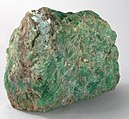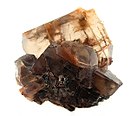Feldspar
The feldspars are a group of tectonic and aluminosilicate minerals that correspond by volume to 60% of the earth's crust. The composition of the rock-constituting feldspars corresponds to a ternary system composed of orthoclase (KAlSi3O8), albite (NaAlSi3O8) and anorthite (CaAl 2Si2O8). Feldspars with a chemical composition between anorthite and albite are called plagioclase, while feldspars with a composition between albite and orthoclase are called alkali feldspars.
Feldspar is an essential component of many igneous, sedimentary, and metamorphic rocks, so many of these rocks are classified based on their feldspar content.
The structure of feldspars can be described as a framework of silicon and aluminum with alkali bases and alkaline earth metals in the void spaces.
Types
They are divided into the following groups:
- Potassic bliss, which are monoclinics, among which are: orthosa, hialofano, anortoclase and sanidine. And the Microclin that's trilinic.
- Plagioclasas (Calcium or sodium feldspartos), which are triclinic, among which are: albita, andesine, anortita, banana, bytownita, dmisteinbergita and labradorite.
- Other feldspastes: Buddingtonite (ammonium feldsparth) and Celsiana (birth feldsparth).
Structure
The structure of a feldspar crystal is based on aluminosilicate tetrahedrons. Each tetrahedron is made up of an aluminum or silicon ion surrounded by four oxygen ions. Each oxygen ion, in turn, is shared by a neighboring tetrahedron to form a three-dimensional lattice. The structure can be visualized as long chains of aluminosilicate tetrahedrons, sometimes described as crank chains because their shape is twisted. Each crank chain joins neighboring crank chains to form a three-dimensional network of fused four-membered rings. The structure is open enough that cations (usually sodium, potassium, or calcium) fit into the structure and provide charge balance.
Etymology
The name feldspar derives from the German Feldspat, a compound of the words Feld ("field") and Spat ("scale"). Spat had long been used as the word for "a rock easily split into flakes"; Feldspat was introduced in the 18th century as a more specific term, perhaps referring to its appearance in the rocks found in the fields (Urban Brückmann, 1783) or in "fields" within granite and other minerals (René-Just Haüy, 1804).
Weathering
Chemical weathering of feldspars occurs by hydrolysis and gives rise to clay minerals such as illite, smectite and kaolinite. The hydrolysis of feldspars begins with the dissolution of feldspars in water, which occurs best in acidic or basic solutions and worse in neutral ones.] The rate at which feldspars weather depends on how quickly they dissolve. Dissolved feldspar reacts with H+ or OH− ions and precipitates clays. The reaction also produces new ions in solution, with the variety of ions controlled by the type of feldspar being reacted.
The abundance of feldspars in the Earth's crust makes clays very abundant weathering products. About 40% of the minerals in sedimentary rocks are clays, and clays are the dominant minerals in older sedimentary rocks. muds. They are also an important component of soils. Feldspar that has been replaced by clay has a calcareous appearance compared to the more crystalline and glassy unweathered feldspar grains.
Feldspars, especially plagioclase feldspars, are not very stable on the Earth's surface due to their high formation temperature. This lack of stability is the reason feldspars easily weather into clays. Due to this tendency to erode easily, feldspars do not usually predominate in sedimentary rocks. Sedimentary rocks containing large amounts of feldspar indicate that the sediment did not undergo much chemical weathering before being buried. This means that it was probably transported a short distance in cold and/or dry conditions that did not favor weathering, and that it was quickly buried by other sediments. Sandstones with large amounts of feldspar are called arkose.
Applications
Feldspar is a common raw material used in the manufacture of glass and ceramics and, to some extent, as a filler and thinner in paints, plastics, and rubber. In the United States, about 66% of feldspar is consumed in the manufacture of glass, including container glass and fiberglass. The rest is used for ceramics (electrical insulators, sanitary ware, crockery and tiles) and for other uses, such as filler.
Glass: The feldspar provides K2O and Na2O to melt, and Al2O 3 and CaO as stabilizers. As an important source of Al2O3 for glassmaking, feldspar is valued for its low content of iron and refractory minerals, its low cost per unit of Al2O3, the absence of volatiles and the absence of residues.
Ceramics: Feldspars are used in the ceramic industry as a flux to form a glassy phase in pastes during firing and thus promote vitrification. They are also used as a source of alkali and alumina in glazes. The composition of feldspar in different ceramic formulations varies depending on various factors, such as individual material properties, other raw materials, and the requirements of finished products. However, typical additions include: tableware, 15% to 30% feldspar; high voltage electric porcelains, from 25% to 35%; toilets, 25%; wall tiles, from 0% to 10%; and dental porcelain up to 80% feldspar.
Earth sciences: In earth sciences and archaeology, feldspars are used for argon-potassium, argon-argon, and luminescence dating.
Minor use: Some household cleaners use feldspar to provide a mild abrasive action.
Images
Contenido relacionado
Tide
Humanity (disambiguation)
Frostbite








![La primera vista por rayos x de feldespato de suelo marciano, piroxeno, olivina mostrado por el rover Curiosity en Rocknest en Marte", 17 de octubre de 2012).[16]](https://upload.wikimedia.org/wikipedia/commons/thumb/1/10/PIA16217-MarsCuriosityRover-1stXRayView-20121017.jpg/126px-PIA16217-MarsCuriosityRover-1stXRayView-20121017.jpg)
